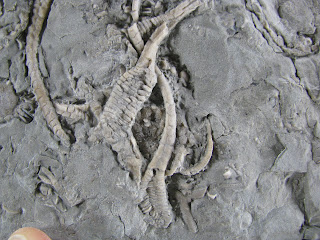I've mentioned before that I don't often have luck with finding Trilobites, well the specimen below is a definite exception to the rule. It's a Ceraurus globulobatus from the Verulam formation. I found it a few years back and a friend, M.T., did the prep work to clean it up. It's not a perfect specimen but it's darn nice. The glabella is slightly crushed and one of the tail spines is missing as well as a small section of shell from the end of the thorax. All in all though, it's a large fossil and a species I never had before.
It is a very flat specimen so perhaps more evolved to swim in the water column?
The eyes are fairly well preserved and not crushed. I am not able to see any lenses though.
Here is what it looked like before it was cleaned up.
I collected this fossil in 2017 at the James Dick quarry near Gamebridge, Ontario. The Verulam formation is late Ordovician in age, Katian/Mohawkian stage.

















































